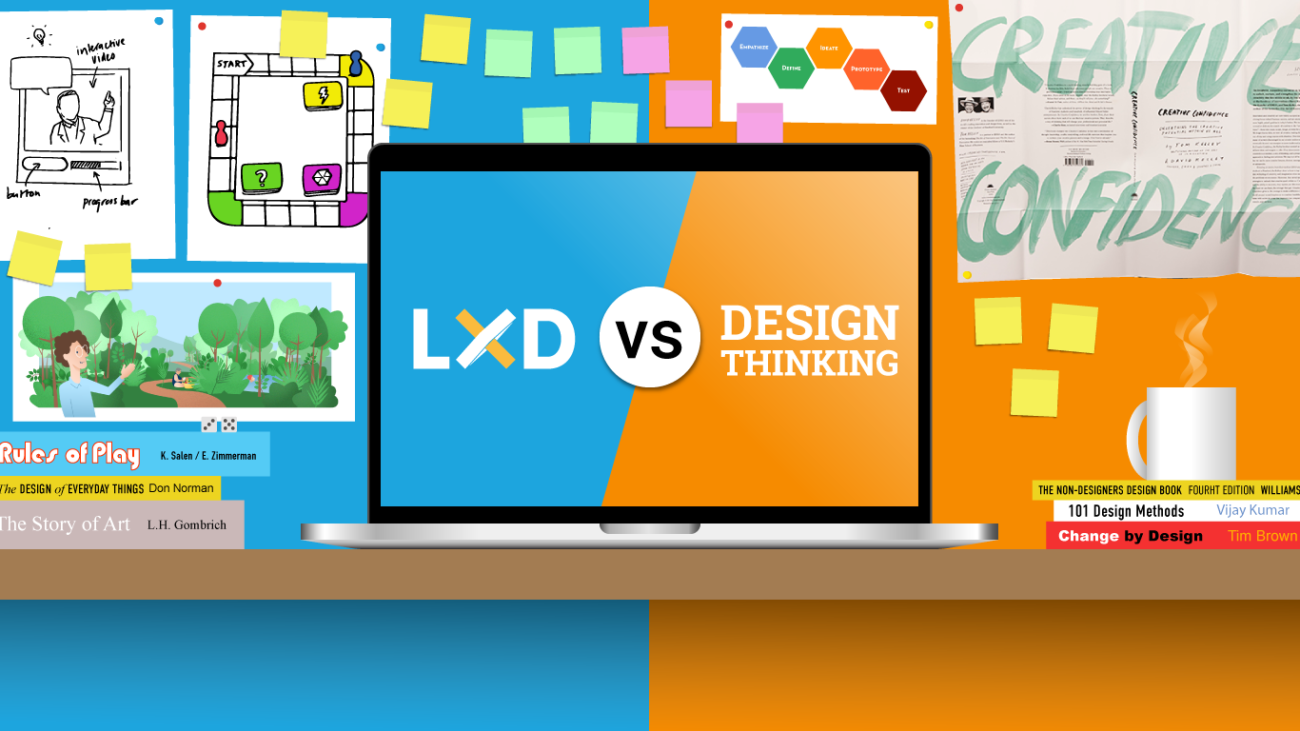December 20, 2021 by Niels Floor |
Learning experience design (LXD) is often associated with design thinking. While there is some truth to this notion, they cannot easily be compared. In this article I would like to zoom in on the differences and similarities between these two different disciplines that do have things in common.
The field of design used to be like an island. A magical place where creative people gathered to make things look, feel, and work better. A great place to be if you’re a designer but not very accessible for people without a design background. Nowadays design is everywhere. Designers have left the island to apply their talents in all kinds of places. Before, design was exclusively used to create things like posters, book covers, interfaces, fashion and furniture. Today designers create services, events, environments and learning experiences.
This cross over from design into other fields coincided with the rise of design thinking. The popularity of design thinking has undoubtedly contributed to the growth of LXD. It has built a bridge from the island of design and allows designers and non-designers to understand each other better and collaborate. That’s good news but it has made it harder to distinguish design thinking from design disciplines like LXD.
What is design thinking?
Design thinking is a methodology for creative problem solving. Traditionally, problem-solving uses a methodical, almost scientific approach. This methodical scientific approach is one of the core qualities of disciplines in the field of learning like instructional design. These disciplines use applied scientific principles for effective instruction, to support learning, and improve performance.
Design thinking uses a fundamentally different approach which is less methodical and more about exploring, experimenting, empathizing, and creating. In this regard, LXD has a lot in common with design thinking as it also offers a radically different approach. That’s no coincidence. LXD is a design discipline just like user experience design, interaction design and graphic design. These are the fields that have inspired design thinking. In other words, when you see similarities between LXD and design thinking it’s because design thinking uses elements that come from design disciplines like LXD.
What’s new about design thinking?
In a way, design thinking is nothing new. Sarah Gibbons from Nielsen Norman Group says: “Throughout history, good designers have applied a human-centric creative process to build meaningful and effective solutions.” LXD is part of this tradition as a creative design discipline that uses a human-centric creative process to come up with extraordinary learning experiences. What’s new about design thinking is how it makes a design approach accessible and applicable on a much wider scale.
Think like a designer
A design thinking course teaches you to think like a designer. There’s great value in this if you don’t have a design background. It offers a fresh perspective which enables you to see new solutions to the problems you try to solve. But there’s a catch: Design thinking doesn’t make you a designer. There’s no short cut for mastering LXD as it requires level of competency in design that goes beyond the application of design thinking.
Design thinking doesn’t make you a designer.
Design thinking is great to come up with original ideas. Turning those ideas into meaningful, engaging, memorable learning experiences is something else. For example, you need to conceptualise, visualise, prototype, test, and iterate your designs. This requires professional design skills that are taught in design schools around the world and take years to develop.
Don’t just think like a designer, be a designer!
I believe that anyone can design a learning experience. I also believe that becoming a LX designer requires specific qualities. Being a designer is one of them. Anyone can draw a poster but it takes a graphic designer to create something special and memorable. If you are truly serious about being a LX designer then don’t just think like a designer, be a designer.
Conclusion
Learning experience design is a multidisciplinary field. It merges several creative design disciplines with the theory and practice of learning. Design thinking is not in the mix. Taking a design thinking course doesn’t turn you into a designer, that requires a much broader skillset and a lot more time and effort.
What I love about design thinking is how it acts as a point of entry to LXD. It opens the minds of non-designers to a more creative approach and it is great if you want to involve people without a design background in the design process for brainstorming and co-creation. Your role as a LX designer is to guide that process and turn their ideas into actual designs.
You don’t have to be a LX designer to benefit from elements of LXD. If you come from the field of learning you can enhance your classes, courses or training by using design thinking. For example, as a teacher you can use design thinking to apply human centered design principles when you re-design one of your classes. While this doesn’t make you a LX designer it does offer valuable benefits and will definitely improve the experiences of your learners.
This article is part of a series which also includes Learning Experience Design vs User Experience Design and Learning Experience Design vs Instructional Design.
Find our more about learning experience design at LXD.org or learn about design thinking at IDEO.

